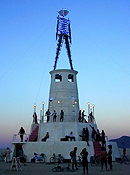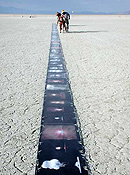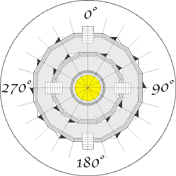 The interactive story of The Floating World involved two props: thick bronze coins with finely bezeled edges and a prepossessing lighthouse. The latter was the pedestal of Burning Man. The text I wrote to introduce this seafaring theme stated, “Our theme is about how we find our way through the world and what we seek and value in it.” Rod Garrett and I designed the coins I dubbed doubloons. One side featured Burning Man positioned at the center of a compass. This was Rod’s idea. On the opposite side, I asked him to draw an archetypical sea chest. Its lid ajar, it overflowed with gold. I wanted to evoke a child’s crude idea of wealth: a hidden stash, a secret treasure, a mythic source of unconditional value. In truth, these freshly minted coins were a McGuffin. This is Alfred Hitchcock’s term for the otherwise meaningless motivator of a plot: the ticking bomb or secret code that urges on the actors as they plummet through a story. In this particular instance, however, the many stories that fleshed out our plot were authored by the actions of participants. Below is a portion of the theme text that introduced this idea.
The interactive story of The Floating World involved two props: thick bronze coins with finely bezeled edges and a prepossessing lighthouse. The latter was the pedestal of Burning Man. The text I wrote to introduce this seafaring theme stated, “Our theme is about how we find our way through the world and what we seek and value in it.” Rod Garrett and I designed the coins I dubbed doubloons. One side featured Burning Man positioned at the center of a compass. This was Rod’s idea. On the opposite side, I asked him to draw an archetypical sea chest. Its lid ajar, it overflowed with gold. I wanted to evoke a child’s crude idea of wealth: a hidden stash, a secret treasure, a mythic source of unconditional value. In truth, these freshly minted coins were a McGuffin. This is Alfred Hitchcock’s term for the otherwise meaningless motivator of a plot: the ticking bomb or secret code that urges on the actors as they plummet through a story. In this particular instance, however, the many stories that fleshed out our plot were authored by the actions of participants. Below is a portion of the theme text that introduced this idea.
A Quest For Treasure
Spirits of good and evil hover near every concealed treasure of the earth. — Joseph Conrad
The treasure to be sought in the Unknown will take the form of gold doubloons imprinted with the likeness of the Burning Man. The possession of this treasure will entitle you to enter the Lighthouse and climb to its top [chamber]… immediately beneath the Burning Man. Here you’ll witness the created chaos of our city as it swirls around you. To be admitted to the Lighthouse, you will be asked by its Keepers to surrender your treasure. You must determine the true value of the coin that you possess. You may retain this object as a piece of property, release it for a passage upward to the Burning Man, or give it to another person as a gift. Under no circumstances, however, is it permissible to barter or sell this coin, nor is it acceptable to collect more than one. This would be unfair to other voyagers who seek treasure. One coin per person is the rule. Each coin should represent an effort by an individual. All who enter into the Lighthouse must solemnly swear to the Keepers that they’ve discovered treasure through their unique efforts or received it as a gift.
At the time, this scramble for imaginary wealth provoked a modicum of controversy. Some bad actors even broke into the lighthouse and absconded with a bag of coins. However, the multifarious search for doubloons produced thousands of dramatic interactions. After the event, hundreds of serendipitous stories filtered back to us. I was gratified to hear that many folks had gifted their doubloon to someone else. We had created what amounted to a fetishized commodity, then posed the underlying moral question: What is of ultimate value? To my delight, a lot of people seemed to sense the answer.
 Two of my more memorable experiences occurred in that year. I and a friend, Randy Bohlender, a Christian pastor, ventured out one night to hide doubloons among the artworks on the playa. I remember placing coins on photographs of mushroom clouds. These belonged to an installation by the photographer Michael Light entitled 100 Suns. He had obtained government photographs of above ground nuclear tests, some of them conducted in Nevada, and laid them out along an LED lit ribbon on the desert floor. I positioned each of my coins precisely at the molten core of these explosions. Finally, I suggested that we hide the treasure in plain sight, calling this the Purloined Letter plan. Nothing in the desert was more visible or trafficked than the lighthouse.
Two of my more memorable experiences occurred in that year. I and a friend, Randy Bohlender, a Christian pastor, ventured out one night to hide doubloons among the artworks on the playa. I remember placing coins on photographs of mushroom clouds. These belonged to an installation by the photographer Michael Light entitled 100 Suns. He had obtained government photographs of above ground nuclear tests, some of them conducted in Nevada, and laid them out along an LED lit ribbon on the desert floor. I positioned each of my coins precisely at the molten core of these explosions. Finally, I suggested that we hide the treasure in plain sight, calling this the Purloined Letter plan. Nothing in the desert was more visible or trafficked than the lighthouse.

Seen in plan, this lighthouse formed a perfect compass: triangular benches had been stationed around its perimeter like compass points. In proper nautical fashion, each of these was divided into bilaterally symmetric black and white fields whose juncture demarcated an exact vector. This pattern of contrasting color bands continued on the railings of the two-tiered structure: wherever facets met, black and white adjoined. Thus, with the aid of a map, one could employ the lighthouse as a compass that would locate artworks on the open playa. I now proposed that we center our coins on each of these dividing lines so that they would blend in with the overall pattern.
 Randy started on one side of the lighthouse, and I attended to the other. My technique, I thought, was pretty devious. I’d palm a doubloon, and then, with studied nonchalance, I’d put my hand upon a railing. Arriving at the topmost tier, I was about to situate my final coin, gently edging it into position, when suddenly I heard someone shouting, “Balloons! Balloons! I wanna balloon!” I was immediately confronted by a very large and very loud woman. She goggled at me, shouting, “Where do I find a balloon? They said you had to have one to get into the lighthouse!” “Madame,” I addressed her, “I believe you mean doubloons.” “Doubloons?” she exclaimed, “What’re doubloons?”. “They are coins, a kind of treasure,” I responded.
Randy started on one side of the lighthouse, and I attended to the other. My technique, I thought, was pretty devious. I’d palm a doubloon, and then, with studied nonchalance, I’d put my hand upon a railing. Arriving at the topmost tier, I was about to situate my final coin, gently edging it into position, when suddenly I heard someone shouting, “Balloons! Balloons! I wanna balloon!” I was immediately confronted by a very large and very loud woman. She goggled at me, shouting, “Where do I find a balloon? They said you had to have one to get into the lighthouse!” “Madame,” I addressed her, “I believe you mean doubloons.” “Doubloons?” she exclaimed, “What’re doubloons?”. “They are coins, a kind of treasure,” I responded.
Leaning forward, I addressed her in a confidential tone, “Treasure is a funny thing, you know. It might be hidden far away and lost in space. But, on the other hand, it could be very close to you.” Staring straight into her eyes, I inconspicuously withdrew my hand. “Huh! ” she barked back, the treasure now glinting between us. Then she stalked away, passing in her progress every one of the 32 coins that we had placed in her path. I waited there for quite some time, hoping that some person in the throng around me would discover treasure and cry out, but all I could hear was her voice, now drifting back to me out of the darkness: “Doubloons! Doubloons! Whose got those damn doubloons?” Now that, I thought, is interaction.
 Three nights later, I gathered up a cache of treasure I’d withheld and headed out to witness the climactic burning of David Best’s masterpiece, The Temple of Joy. By the time I arrived, a dense crowd had gathered along its safety perimeter. I proceeded to traverse the outer portion of this circle with my bag of coins. Approaching strangers, I’d enquire, “May I offer you a gift?” As I recall, only two or three people rebuffed me that night, but many others asked, “What is it?”, and I’d gently reproach them, “I’m only asking if I can offer it to you.” When they nodded, I’d produce the coin and watch their eyes light up in recognition. I’d hold it out, they’d reach for it, and then I’d quickly take the person’s hand. Pressing the doubloon into an upturned palm, I would explain, “It’s treasure.” Then, I’d squeeze it twice again. This time I would impress the coin a bit more deeply in their flesh and say, “It is a gift!”
Three nights later, I gathered up a cache of treasure I’d withheld and headed out to witness the climactic burning of David Best’s masterpiece, The Temple of Joy. By the time I arrived, a dense crowd had gathered along its safety perimeter. I proceeded to traverse the outer portion of this circle with my bag of coins. Approaching strangers, I’d enquire, “May I offer you a gift?” As I recall, only two or three people rebuffed me that night, but many others asked, “What is it?”, and I’d gently reproach them, “I’m only asking if I can offer it to you.” When they nodded, I’d produce the coin and watch their eyes light up in recognition. I’d hold it out, they’d reach for it, and then I’d quickly take the person’s hand. Pressing the doubloon into an upturned palm, I would explain, “It’s treasure.” Then, I’d squeeze it twice again. This time I would impress the coin a bit more deeply in their flesh and say, “It is a gift!”
 So intent was I upon this self-appointed mission that I almost missed the Temple burn. At some point, however, my cache of coins dwindled down, and I heard a vast intake of breath all around me. A flock of wild birds had suddenly appeared. Attracted by the light, they circled the huge gout of boiling flame — then circled it a second time and disappeared into the night. This, I think, is one of the most beautiful things that I have witnessed in the Black Rock Desert, and I will never forget it. It felt, beyond all reason, as if nature had conspired to give me a gift. This escapade is probably the closest I have come to explicitly expressing the inherent moral of a theme. A certain reticence constrains me, and it goes to the heart of the ethos that Burning Man has generated. This is communicated by the last of the Ten Principles that I originally wrote in a little zocalo in Mazatlan: “Immediate experience is, in many ways, the most important touchstone of value in our culture. We seek to overcome barriers that stand between us and a recognition of our inner selves, the reality of those around us, participation in society, and contact with a natural world exceeding human powers. No idea can substitute for this experience.” No better rubric could convey what interactive art can do.
So intent was I upon this self-appointed mission that I almost missed the Temple burn. At some point, however, my cache of coins dwindled down, and I heard a vast intake of breath all around me. A flock of wild birds had suddenly appeared. Attracted by the light, they circled the huge gout of boiling flame — then circled it a second time and disappeared into the night. This, I think, is one of the most beautiful things that I have witnessed in the Black Rock Desert, and I will never forget it. It felt, beyond all reason, as if nature had conspired to give me a gift. This escapade is probably the closest I have come to explicitly expressing the inherent moral of a theme. A certain reticence constrains me, and it goes to the heart of the ethos that Burning Man has generated. This is communicated by the last of the Ten Principles that I originally wrote in a little zocalo in Mazatlan: “Immediate experience is, in many ways, the most important touchstone of value in our culture. We seek to overcome barriers that stand between us and a recognition of our inner selves, the reality of those around us, participation in society, and contact with a natural world exceeding human powers. No idea can substitute for this experience.” No better rubric could convey what interactive art can do.

